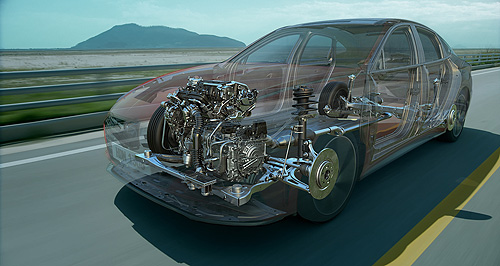CVVD kicked in, yo: Hyundai’s CVVD technology will allow precise control of valve opening and closing durations to boost performance when driving hard as well as improve efficiencies when cruising.
HYUNDAI has built a mass-production Continuously Variable Valve Duration (CVVD) petrol engine that can boost performance and improve efficiencies, which will debut in the Sonata Turbo later this year, as well as in sister-brand Kia vehicles, in 1.6-litre form.
Said to reduce fuel consumption and carbon dioxide emissions by five and 12 per cent respectively, the CVVD engine also marginally increases outputs by four per cent by precisely controlling the opening and closing of valves on the fly.
“When the vehicle is maintaining a constant speed and requires low engine output, CVVD opens the intake valve from the middle to end of the compressions stroke,” Hyundai said in a press release.
“On the other hand, when engine output is high, such as when the car is driving at a high speed, the intake valve is closed at the beginning of the compression stroke to maximise the amount of air for the explosion, enhancing torque to improve acceleration.”
While valve timing control has been around for decades, such as in Honda’s VTEC and Toyota’s VVTi-L systems, Hyundai says “previous variable valve control technologies could not regulate valve duration, as the valve’s closing timing was subordinate to opening timing and could not respond to diverse driving situations”.
Shown alongside the CVVD announcement was the Korean car-maker’s new Smartstream G1 1.6-litre T-GDi engine, which – surprisingly – features a V4 layout.
With a turbocharger in tow, the new engine produces 134kW of power and 265Nm of torque.
By comparison, the turbo-petrol 1.6-litre inline four-cylinder unit found in the current Kona develops 130kW/265Nm returns a fuel consumption figure of 6.7 litres per 100km and emits 153 grams of carbon dioxide per kilometre when paired with a seven-speed dual-clutch automatic transmission and all-wheel drive.
Aside from the cutting-edge CVVD technology, the new mill also features an integrated thermal management system to quickly bring the engine up to temperature, a 350-bar direct spray system and a 34 per cent reduction in friction.
Hyundai Motor Group research and development division head and president, and BMW M’s former head, Albert Biermann said the new CVVD system is a marked step forward in engine technologies for the brand.
“The development of the CVVD technology is a good example how Hyundai Motor Group is strengthening our powertrain technology,” he said.
“We will continue our innovation efforts to bring forth paradigm shifts and ensure sustainability of our business model.”



















Facebook Twitter Instagram